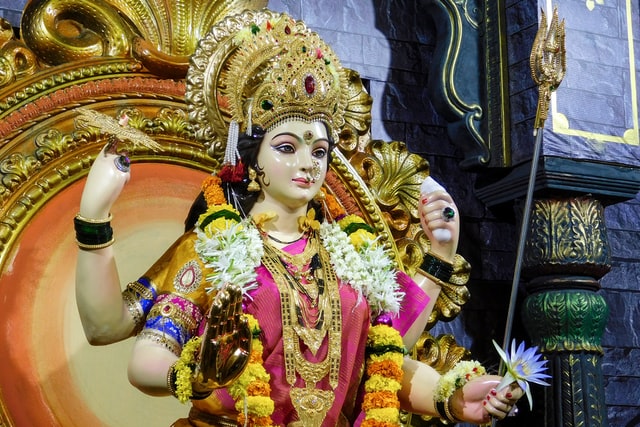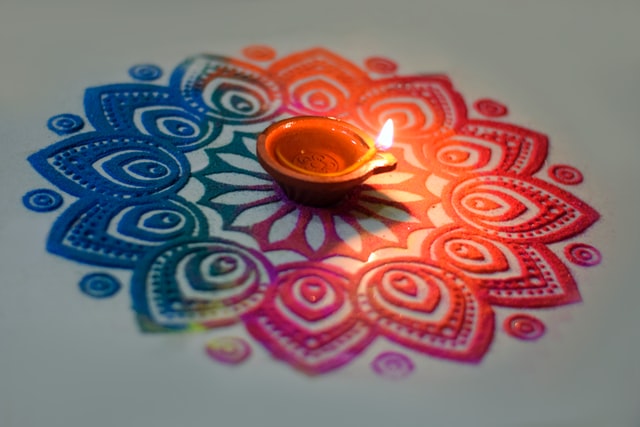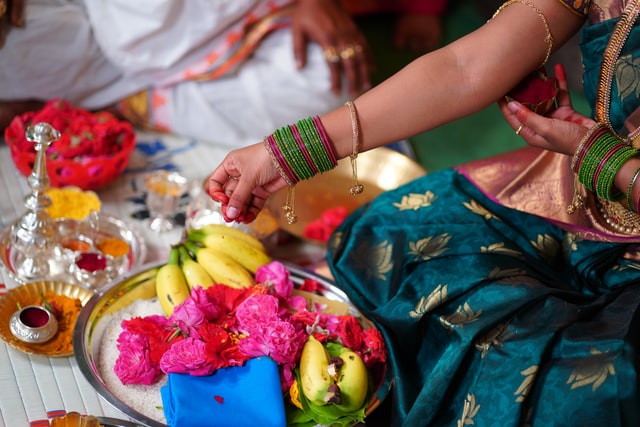Dhanteras | Vidhi | Shubh Muhurat | Mantras Chanting | Celebration Day | Story Behind | Another Story | Dhanteras Celebration | Goddess Lakshmi | Significance | Eco-friendly | South Indian Celebrations | Well Wishes
A day set aside for worshipping Lord Dhanvantari, Goddess Lakshmi, Lord Ganesha, and Lord Kubera marks the start of the Diwali celebration, which is popularly known as “Dhanteras.” It is a very special day. Dhanteras Puja at home marks the beginning of the much-awaited festival, which concludes with the Bhai Dooj ritual. The Sanskrit roots of the term “Dhanteras” are “Dhan” (wealth) and “teras” (the thirteenth day of the Hindu lunar calendar).
Also, check these ideas for Ganapati decoration at home and house interior designs.
Why is Dhanteras Auspicious?
According to legend, Goddess Laxmi emerged from the Milk Ocean on this day, representing wealth, as the ocean was churning. People typically buy everything they desire, whether gold, silver, a car, a house, or something else entirely. We see this day as lucky for purchasing valuable items.

Dhanteras Puja at Home – Vidhi (Process)
You can use an altar or the temple in your house for the puja. Take a wooden chowki and spread some rice and a red cloth over it. Place an oil or ghee lamp on the rice and light it.
Do Dhyana (connect your inner self with God) after that. Spread some rice on the ground and position an idol of the goddess Lakshmi to her left, followed by an icon of the Lord Ganesha. The asana is the layer of rice at the bottom (seat). Pay homage to Lord Ganesha before starting the ritual. You must serve Lord Ganesha with all the offerings first.
If you have statues of Lord Kubera and Lord Dhanvantari, you can also set them on the chowki after spreading some rice on top to serve as an asana for them. Use two superiors and completely cover them in Kaleva if you don’t have idols of Lord Kubera and Lord Dhanvantari (sacred thread). Then you are free to mount them on the chowki as idols of these deities.
Shubh Muhurat (Auspicious Time)
“Shubh Muhurat” refers to the time of day that Hindus believe to be the most fortunate for completing all religious rites. The Shubh Muhurat for this year’s Dhanteras puja at home celebration runs from roughly 5.42 pm to 7.31 pm.
In the evening, we perform Dhanteras puja at home. One provides wheat and a variety of pulses in addition to fresh flowers and prasad. As part of the Dhanteras puja, we paint little footprints with vermilion near the front door to represent the welcome of Goddess Lakshmi.
Many individuals also remove their silver and gold jewelry from their lockers and clean it with milk, curd, honey, and holy water. On this day, people also purchase new gold or silver. Then we perform an aarti.
Chanting of Mantras
- Padya – (pour a small amount of water at the Lord’s feet)
- Arghya – (offer a drop or two of water to the Lord)
- Aquaman – (drink water from your palm after showing it to God) = If you want to perform the Abhishek, gently arrange the idols of each deity on a plate one after the other and proceed as before.
- Snana – (Provide water for the Lord to bathe in) = Only if the idols are constructed of metal may one perform the Abhishek using liquids such as water, milk, coconut water, Gangajal, honey, curd, etc. If you complete the Abhishek, softly spray water on each idol at the conclusion and then wash them down with a clean cloth.
- Vastra = Present the god with a clean piece of cloth. You can use two pieces of little kalava as vastra, one for each of the gods.
- Yagnopaveeth = Offer Lord Ganesha, Lord Dhanvantari, and Lord Kubera the holy Janeyu and Akshat. Offering flowers, akshat, kumkuma, Haldi, and Chandan to the light is another way to worship it.
Then present Haldi, Kumkuma, Roli, and Akshat to the gods. Offer Chandan paste or itra/natural smell to Gandha (to all the deities)
By worshipping Lord Dhanvantari, the god of Ayurveda, people also observe this day as Dhanvantri Jayanti. Lord Dhanvantari, who taught Ayurveda to humanity, celebrates his birth on Dhanteras, and in the evening, people pray to the health deity to be healed.
Day of Celebration – Performing Dhanteras Puja at Home
The celebration of Dhanteras, which takes place annually on the same day as Krishna Paksha Trayodashi in the month of Kartika just before the festival of Diwali, is based on this mythology. The widely held conviction among Hindus that Dhanteras is the surest means to attract riches into the household. Also, desiring the long life of the spouse has helped maintain this sacred practice.
The Story Behind the Festival
Like many Indian holidays, this day is associated with well-known Hindu myths. Dhanteras, the occasion on which people worship Lord Yamaraja, has a fascinating backstory. This holiday is associated with many mythological tales. The most famous story is that of King Hima.
According to mythology, an astrologer informed King Hima on the fourth day following his wedding. When his wife heard this prophecy, he placed all of her jewels made of priceless gold and silver at the entrance to the bedroom and lit an oil lamp in the evening.
As he approached King Hima to assassinate him, the Lord of Death, Yama, appeared as a serpent. The bright lamps and glittering jewelry dazzled the snakes’ sight, making them blind. Instead of killing King Hima, he ascended the jewels mound and began listening to the king’s wife tell stories all night long.
Continuation……
Yama had to go back without killing King Hima. Later, this day became known as Dhanteras, and people continued to light lights and adorn themselves with jewelry on this day. Diyas or oil lamps are lit to protect the family from the grasp of death.
Legend has it that on the fourth day of his marriage, King Hima’s 16-year-old son will pass away from a snake bite. When the son’s wife learned this, she decided to keep her husband awake by telling him stories all night long and setting a collection of decorations at the door to her room.
To bite King Hima’s son, Lord Yama appeared in the form of a snake. He sat on the pile of jewelry, though, and listened to the tales while being mesmerized by the jewelry. As a result, Lord Yama was diverted by the new bride and missed the time allotted for killing the prince. Since King Hima’s son was saved, metal has been associated with luck and success.
Another Story
Emerging from the ocean and stirring up the gods and demons on the day of dhanteras, the legend of Lord Dhanvantari, the divine doctor and a manifestation of Lord Vishnu, is another intriguing and well-known tale.
Since then, Dhanteras has become one of the most fortunate days and a major Hindu holiday. In the evenings, they also pray to Lord Yamaraja, the God of Death, and worship him. People clean their homes and decorate them with lights and diyas just before Diwali to ward off evil spirits and bad energies.
Celebrations of Dhanteras Puja at Home
Vasu Baras announce the start of the Diwali holiday celebrations. We worship the cow and her calf on Vasubaras as they are highly respectful in Vedic culture. We admire her as “Gau Mata” (mother cow) and raised her with the highest respect.
In all Hindu festivities, the name “Gau Mata” and her prasad, we utilize “Pancha Gavya” or “Panchamrut” widely. Dhanteras comes after Vasubaras. We worship Lord Dhanvantari during Dhanteras. Hindu mythology claims that Lord Dhanvantari appeared during Samudra Manthan while carrying the sacred book of Ayurveda.
He also carried a Kalasha full of Amrit, an Ayurvedic herbal mixture that confers immortality and is revered as the Vaidya of the Gods. We celebrate the festival when clay lamps (Diyas) are lit in the evenings for Lakshmi Puja. We sing Bhajans, devotional songs that honor Goddess Lakshmi when we offer Naivedhya or traditional sweets to the Goddess.
A strange tradition exists in Maharashtra where individuals softly pound cane sugar (jaggery) with dried coriander seeds (Dhane in Marathi for Dhanatrayodashi) and offer the concoction as Naivedhya.
Welcoming Goddess Lakshmi into the House

Rangoli patterns decorate entrances to welcome the Goddess of wealth and prosperity. The rice flour makes tiny footprints that signify her long-awaited arrival. The night before Lakshmi Puja, we light small clay diyas to represent the removal of bad luck for the entire year.
To express our gratitude and gladness for Devi Lakshmi’s kind grace, we sing bhajans in her honor and gift Naivedya with traditional sweets. During Dhanteras puja at home, keeping the lamp lit all night, we see it as lucky since there is a belief that even the God of Death returns to his abode without touching his victim. It is thought that the lamps’ light will bring good fortune, good health, and long life.
Significance of Dhanteras Puja at Home
Dhan, which signifies wealth, and Teras, which denotes the thirteenth day, are the two words that make up the phrase Dhanteras. It is observed on the thirteenth lunar day of Krishna Paksha, or the dark fortnight, in the month of Ashwin, according to the Hindu calendar. Dhanatrayodashi and Dhanvantari Trayodashi are other names for Dhanteras.
Goddess Lakshmi emerged from the ocean of milk on the day of Dhantrayodashi as the sea was being disturbed. As a result, on the day of Trayodashi, people worship the goddess Lakshmi. [10] The holy scriptures, however, claim that this worship is not recorded anywhere in our sacred writings.
A well-known myth states that on the day of Dhanteras, when the devas and asuras carried out the Samudra Manthan (ocean churning) for Amrita (the divine nectar of immortality), Dhanvantari (the healer of the Gods and a manifestation of Vishnu) appeared carrying a jar of the nectar.
Eco-friendly Celebrations
Use recycled or handmade paper, clay palm leaf, jute, or lanterns made of other materials rather than plastic. You can paint the puja thali or decorate it with turmeric powder, kum kum, and fresh flowers.
On this night, we place lights set out in diyas, in front of doorways of homes, sky lamps, offerings at the foot of a Tulsi plant, and other methods. We offer this light to Yama, the Host of Death, to avoid an early death during the Diwali festival, a celebration intended to boost prosperity and fortune. As represented by Lakshmi, Dhanteras embraces themes of purification, rejuvenation, and securing auspiciousness.
A Unique Way of Celebration by South Indians
On the eve of Naraka Chaturdasi or Dhanvantri Trayodashi, Brahmin women in South India (particularly Tamil Nadu) prepare “Marundhu,” which translates to “medicine.”
On Naraka Chaturdasi, before the sun rises, they offer the Marundhu during the prayer and consume it. In reality, many families teach their daughters and daughters-in-law to cook Marundhu dishes. They ingest Marundhu to correct the tri doshas imbalance in the body.
Well wishes
May you receive a massive rain of wealth on this auspicious festival of Dhanteras, and may the success light gloriously envelop your life, Cheers to Dhanteras!

